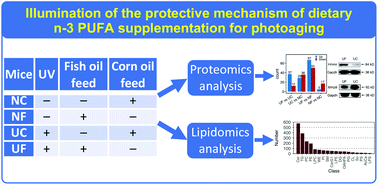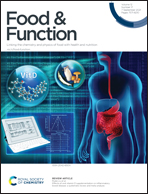Proteomics and lipidomics reveal the protective mechanism of dietary n-3 PUFA supplementation for photoaging†
Abstract
Chronic ultraviolet radiation exposure could induce photoaging, and even carcinogenesis. Dietary omega-3 polyunsaturated fatty acid (n-3 PUFA) supplementation has proved to alleviate photoaging and cutaneous carcinoma. Although the exact mechanism remains poorly elucidated, accumulated evidence suggests that the alleviation effect of n-3 PUFA for photoaging is a multifactorial procession characterized by different pathways. Here, we performed a whole-genome proteomics and lipidomics analyses using a self-constructed photoaging mouse model with n-3 PUFA or n-6 PUFA supplementation. Significant alleviation of photoaging was observed, and a total of 88 differentially expressed proteins and 152 differentially expressed lipids were identified in mice with n-3 PUFA supplementation. We found that n-3 PUFA may alleviate photoaging by upregulating Hmmr (hyaluronic acid receptor) expression, which can decrease Mmp9 expression, reducing collagen degradation. As most proteins were associated with lipogenesis and lipid metabolism, we further analyzed the lipidomics data, finding that most triglycerides (93%) showed a significant increase in the n-3 PUFA supplementation group. Our proteomics and lipidomics results indicate that the protective mechanism of n-3 PUFA for photoaging is complicated. Furthermore, the effect of elevated triglycerides by n-3 PUFA supplementation in counteracting skin photoaging cannot be ignored, which will become a new prime target in anti-photoaging.



 Please wait while we load your content...
Please wait while we load your content...